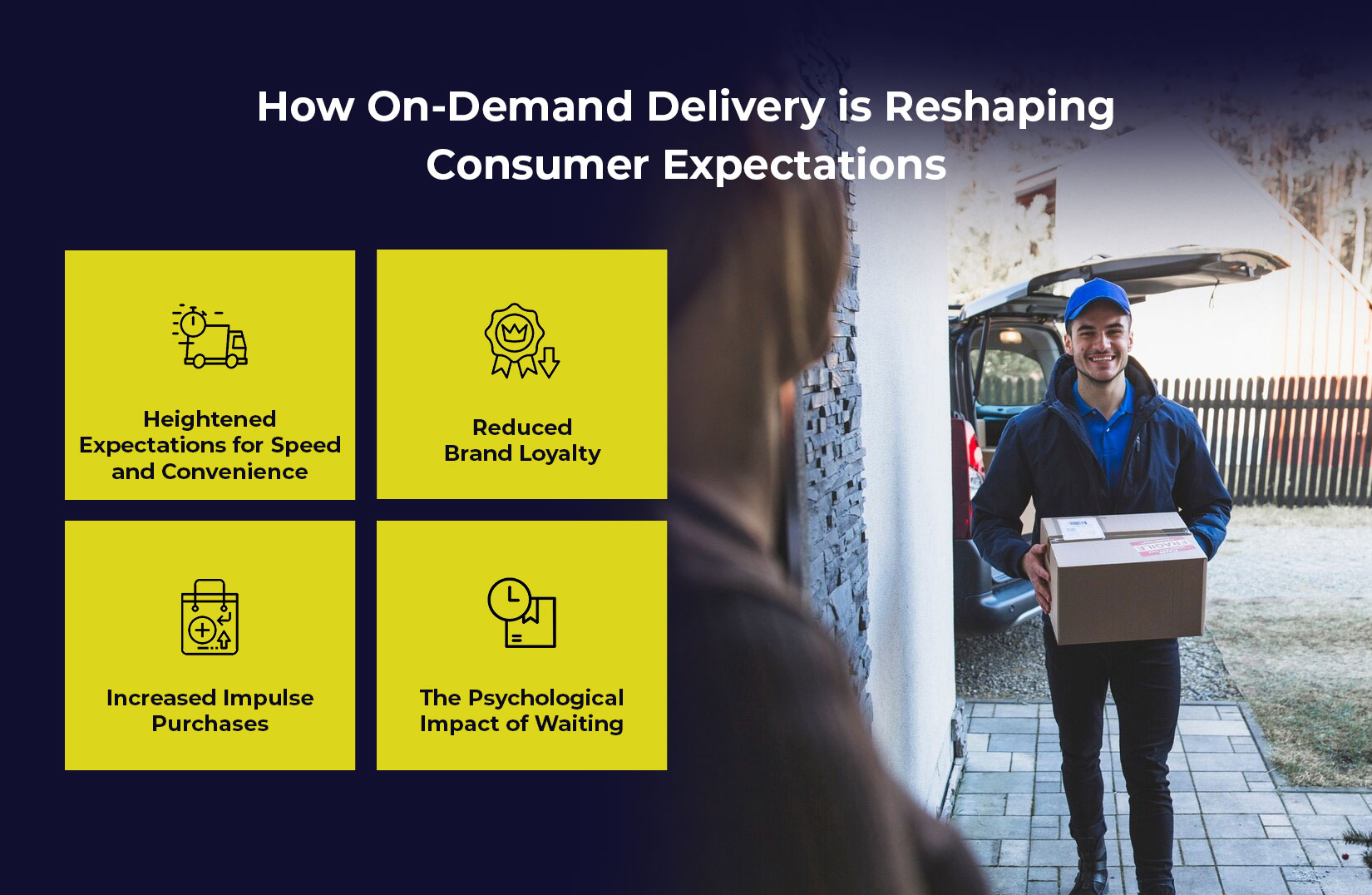
The Psychology of Instant Gratification: How On-Demand Delivery is Shaping Consumer Behavior
In today’s fast paced digital economy, consumers expect convenience at their finger tips. The rise of on-demand delivery services has not only transformed industries but also significantly influenced consumer behavior. The psychology of instant gratification plays a crucial role in shaping purchasing decisions. This leads businesses to adopt advance technologies and strategies to meet these evolving demands.
The Instant Gratification Phenomenon
Instant gratification is the desire to experience pleasure or fulfillment without delay. In a world where people can access information, entertainment and products instantly, waiting has become an inconvenience. This psychological shift has fueled the demand for on-demand delivery solutions, allowing consumers to receive goods and services faster than ever before.
Studies show that 88% of consumers are willing to pay for same-day or faster shipping. Furthermore, a report from PwC indicates that 41% of shoppers are willing to pay extra for same-day delivery. Whereas 24% are open to paying even more for one- or two-hour delivery windows. This statistic underscores the growing impatience among modern shoppers and the need for businesses to optimize their delivery processes. The best software integrates real-time tracking, predictive analytics, and automation to ensure seamless service.
How On-Demand Delivery is Reshaping Consumer Expectations

1. Heightened Expectations for Speed and Convenience:
The success of companies like Amazon, DoorDash, and Instacart has set new standards for delivery speed. Consumers now expect businesses across all industries to offer fast, reliable, and efficient services. This trend has led to the adoption of robust systems that can handle large volumes of orders without delays.
A study by Metapack found that 96% of consumers consider fast delivery a key factor in their purchasing decisions. Additionally, 55% of online shoppers abandon their carts due to slow delivery options. This emphasizes the need for speed in modern commerce.
2. Reduced Brand Loyalty:
While brand loyalty was once a cornerstone of consumer behavior, the demand for instant gratification has shifted priorities. Customers are more likely to choose a brand that offers a faster and more convenient solution over one they have been loyal to for years. A study by McKinsey found that 39% of consumers switch brands for faster delivery options.
3. Increased Impulse Purchases:
The availability of on-demand delivery software has amplified impulse buying behavior. When consumers know they can receive a product within hours, they are more likely to make spontaneous purchases. According to a survey by CreditCards.com, 77% of Americans admit to making impulse purchases, with nearly 40% saying they do so frequently. Retailers leverage this behavior by offering limited-time deals and personalized recommendations to drive sales.
4. The Psychological Impact of Waiting:
Waiting for a product to arrive can create anxiety, especially when consumers are used to immediate gratification. On-demand delivery systems mitigate this by providing real-time tracking and estimated delivery times, keeping customers informed and engaged throughout the process. Studies indicate that transparency in delivery updates increases customer satisfaction by up to 70%.
The Role of Technology in On-Demand Delivery
To meet growing consumer expectations, businesses are turning to technology-driven solutions. The best on-demand delivery software incorporates artificial intelligence (AI), machine learning, and automation to enhance operational efficiency. Some key advancements include:
– AI-Powered Logistics: AI algorithms optimize delivery routes, reducing delays and improving efficiency.
– Real-Time Tracking: Customers can monitor their orders in real-time, reducing uncertainty.
– Predictive Analytics: Businesses can forecast demand and manage inventory effectively.
– Automated Dispatching: Orders are assigned to the nearest available driver, ensuring faster deliveries.
A 2023 study by Statista projects that the global on-demand delivery market will grow to $335 billion by 2030, driven by advancements in automation and AI-powered logistics solutions.
Industries Benefiting from On-Demand Delivery
On-demand delivery is no longer limited to food and retail. Various industries have adopted this model to enhance customer satisfaction and streamline operations. Some of these include:
– Healthcare: Pharmacies and medical suppliers use on-demand delivery systems to provide patients with timely medications and healthcare products.
– Grocery: Services like Instacart and Walmart+ have revolutionized grocery shopping with rapid delivery options.
– E-Commerce: Online retailers leverage on-demand delivery software to offer same-day or next-day shipping.
– Hospitality: Hotels and travel businesses use on-demand delivery solutions to provide seamless guest experiences.
The Future of On-Demand Delivery
As technology advances, the future of will see innovations like drone deliveries, autonomous vehicles, and blockchain-driven logistics. The demand for instant gratification will continue to drive businesses to refine their strategies, ensuring that they remain competitive in an evolving market.
A report from McKinsey states that 25% of consumers expect drone delivery to be a standard service within the next decade, reflecting the growing preference for even faster fulfillment methods. Businesses that fail to implement efficient on-demand delivery solutions risk losing customers to competitors that prioritize speed and convenience. Investing in the best on-demand delivery software will not only enhance operational efficiency but also improve customer satisfaction, leading to higher retention rates.
Conclusion
The psychology of gratification has reshaped consumer behavior, making speed and convenience key decision-making factors. It has become an essential service across various industries, influencing purchasing habits and brand preference. Companies that embrace technology-driven on-demand delivery systems will remain ahead of the curve, meeting the growing expectations of modern consumers.
Advanced on-demand delivery solutions enable businesses to significantly improve customer experiences and boost sales. In a market where speed is crucial, these solutions also allow companies to position themselves as industry leaders. Thus, its a necessity to use the best on-demand delivery software like the one provided by LogiNext Solutions. So, book a demo today by clicking on the red button below.
31







@LogiNext